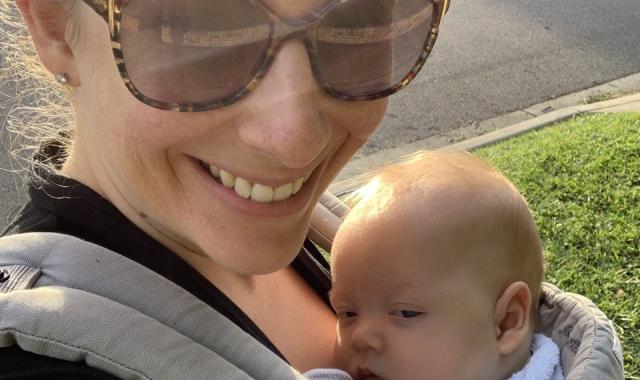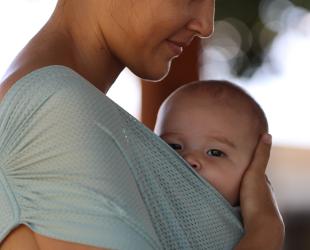A carrier, wrap or sling can be a practical and safe way to carry your baby or young child.

A carrier can help when your baby is fussy, when they won’t sleep, when you’re out and about or when you just need to have your hands free to do things or help other children.
Baby carriers can help breastfeeding
Baby wearing keeps your baby close and makes it easier for you to notice your baby’s feeding cues. This helps you respond more quickly when your baby needs a breastfeed.
Having your baby close to your chest promotes the release of hormones that help you make milk and bond with your baby.
With some carriers it's even possible to breastfeed your baby without taking them out. This can make breastfeeding while out and about quick and easy, as you won't need to find a place to sit down.
Some types of carriers are easier to breastfeed in than others. You may like to think about this when choosing a carrier.
Tips for breastfeeding in a carrier
To breastfeed while your baby is in a carrier, you may need to adjust your baby’s position and/or loosen the straps.
- Use a carrier that you can adjust safely and easily while carrying your baby. Carriers that have fabric or straps between you and your baby may be more difficult to feed in.
- Choose clothes (and a bra) that you can easily move out of the way. Lifting a shirt up can be hard when your baby is against your body.
- Loosen the carrier so your baby is lower and in line with your nipple.
- Adjust the carrier so your baby can move their head freely.
- Support your baby with your hands while feeding. Using your arms to take some of their weight can make it more comfortable for you as well as your baby.
- Once your baby has finished feeding move them back into position following the T.I.C.K.S. checklist.
Other safety tips
Be careful when putting your baby into or getting them out of a carrier. Ask for help if necessary.
Read and follow all manufacturer's instructions for use. Check the carrier regularly for wear and tear.
Ensure your baby’s hips are in a healthy position, with their legs spread wide, thighs supported and hips and knees bent.
Check on your baby often, especially if they’re young. In warmer weather, check your baby isn’t overheating.
Remove any thick or puffy layers of clothing before putting your baby in the carrier. If you need more warmth add a jacket over your back and the carrier. If your baby is cold, add a layer over the carrier on your front leaving your baby’s head uncovered. Using layers allows you to adjust for warmth or cold without taking your carrier off.
Be careful of your own safety. Carrying your baby can affect the way you move, particularly on stairs.
Avoid activities which may be dangerous while wearing your baby e.g. cooking over an open flame, using hazardous chemicals or running after other children.
What if my baby sleeps in the carrier?
Being carried against a parent’s body can often lull a baby to sleep. Newborns, in particular, may spend a lot of their time in a carrier asleep. You may wonder if this is safe for your baby.
The two main things to make sure of are that your baby can breathe easily and that they aren’t overheating.
- Check that your baby’s position in the carrier stays safe. A young baby may not have enough body strength or control to keep their head high their chin off their chest. It’s easy for a sleeping baby’s head to roll forward. Make sure your baby doesn’t slip down in the carrier. Ensure their face isn't covered by any fabric or your body.
- Check that your baby isn’t overheating. Carriers hold a baby firmly and it’s easy for them to get too hot against your body.
It’s important that you are awake and aware of your baby at all times when using a baby carrier.
© Australian Breastfeeding Association February 2025


